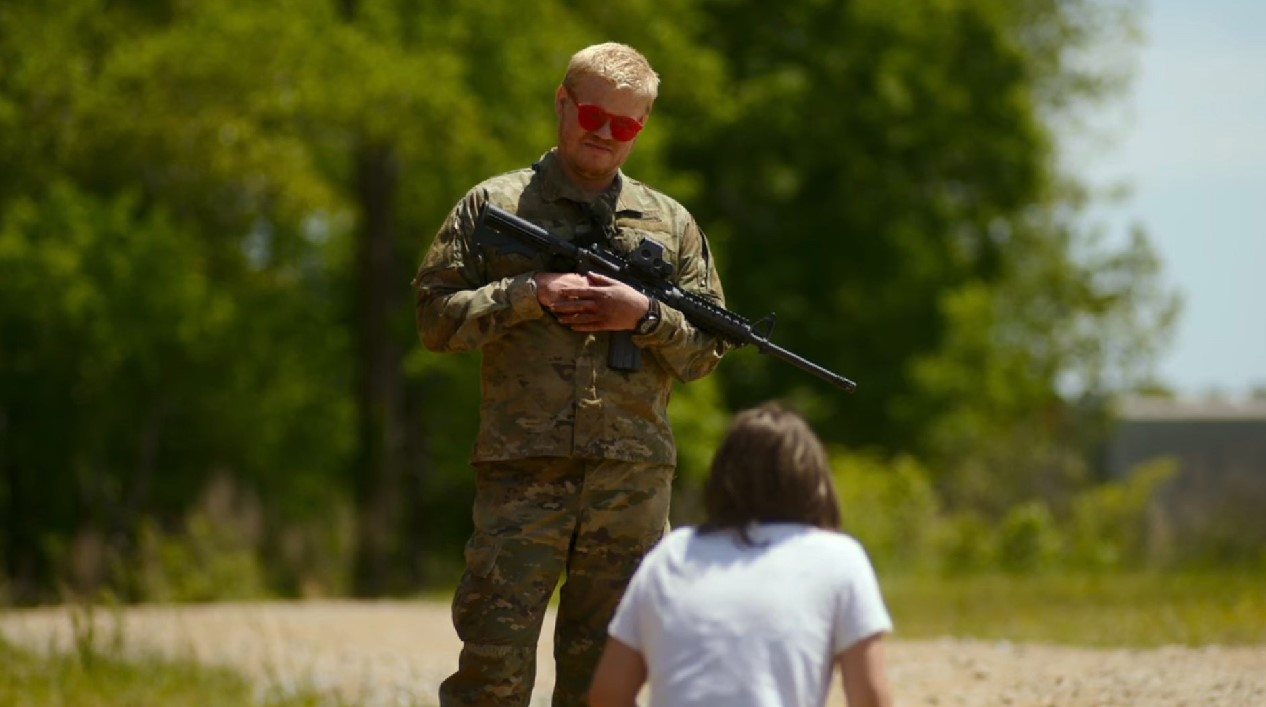The new film Civil War may want to be edgy, timely, even thoughtful, but it has nothing to offer beyond surface-level thrills, which makes its grisly portrayal of war feel more like a romanticization of the worst in humans than a warning against it.
Alex Garland’s latest (and potentially last) directorial effort has garnered a lot of attention for its explicitly political premise: imagining a near-future America that has become embroiled in a civil war. During a time when America is divided enough that a number of people are predicting—and in some cases seemingly calling for—a new American civil war, you can understand the interest.
Despite such a politically charged premise, it became clear in interviews (like those with star Nick Offerman) that the movie wasn’t itself going to be very political, at least not in a partisan way. If the movie wasn’t going to try to say something about our modern-day politics, then what was it going to say? As it turns out, not much.
Civil War follows a group of war journalists, led by the legendary war photographer Lee Smith (Kirstin Dunst), as they travel across a war-torn United States to interview the fascistic three-term president (Nick Offerman) before the band of states united against him (often referred to as “The Western Forces,” including places like California and Texas) launch their planned attack on the White House.
The film makes an admittedly visually compelling contribution to the “post-apocalyptic USA” genre. The filmmakers put us in an America that looks like the war-torn foreign countries we’re used to seeing in movies and on the news, but juxtaposes them with familiar locations like malls and classic New York and D.C. landmarks. Unlike other post-apocalyptic films, like Zombieland and Mad Max, which are closer to fantasy, Civil War features a vision of the world that’s realistic and contemporary. This creates an aesthetically arresting portrait that is deeply affecting the first few times you see it.
Unfortunately, once you scratch the surface, there isn’t much to the movie. Its aesthetically arresting imagery built around the dissonance of seeing American shopping malls looking like the set of any other overseas war-torn conflict feels repetitive after around 20 minutes, and these visual motifs never develop into anything meaningful or explanatory. This wouldn’t be too bad if the characters were compelling, the worldbuilding was thoughtful, or the social commentary or themes were deep. But the film doesn’t spend any time beyond the bare minimum developing any of these things.
Granted, the cinematography of Civil War is legitimately breathtaking. Most films looking to ground their visuals in the kind of gritty realism Garland is going for opt for a documentary look, with a shaky-cam effect and colors at a more “objective” saturation level to attain that feeling of realism we associate with documentaries. The handheld camera approach, however, tends to create a barrier between us and both the characters and the action. But the camerawork in Civil War retains a documentary feel while keeping the images smooth, the colors expressive, and our interest engaged. These make scenes like the protestors’ opening clash with the president’s fascist police, the shootout between a small group of the Western Forces and the President’s military a little later, a pile of bodies in a ditch, and the finale truly nail-biting and jarring. (Alex Garland spoke to Empire about the “revolutionary” new camera technology he used that made this approach possible.)
The actors also sell the movie even when the movie isn’t selling itself—powering the film with convincing vulnerability and energy. Jesse Plemons as an unnamed soldier and Offerman are effortlessly convincing in their small but pivotal scenes. Wagner Moura is a standout among the main characters as Lee’s number two, Joel, maintaining lovable trustworthiness whether he’s being a reliable buddy, a jaded veteran, or an emotional wreck. Cailee Spaeny has an earnest passion that makes whatever cliche character moment she’s given feel believable. Finally, Kirstin Dunst is given less to do as the stoic lead, but she still evokes a warmth that infuses humanity into her world-weary cynicism.
And yet … even the fine acting can’t quite overcome the fact that these characters are surface-level archetypes who recite cliches between violent set pieces. Lee is the battle-hardened veteran. Jesse is the fresh-faced young blood who wants to be just like Lee. Sammy is the kindly wise veteran on his last legs. All these characters go through arcs pretty much exactly the way you expect—except when they’re making wildly idiot choices that are required to set up the next plot point.
The worldbuilding likewise consists of the war-torn America imagery and passing lines about “what’s left of the New York Times” and “The Antifa Massacre,” which are never developed further. There is no commentary to be had on politics or war or America related to how we got to this place.
Let me be clear. Not every movie has to have deep character development or social commentary. Some can be largely built around their aesthetics or action, such as the John Wick franchise. But although John Wick consists mostly of fight scenes in neon-light-soaked sets, it continues to develop those sequences in new and fascinating ways. Civil War makes most of its visual statements early on, and largely repeats them rather than develops them. This makes you feel the lack of deep character, worldbuilding, or commentary once the visual motifs start to repeat themselves.
There is yet another problem with Civil War’s approach. Its combination of realistic, dehumanizing brutality and thematic shallowness crosses the line into some morally problematic territory. While John Wick focuses on violence as stylized ballet, Civil War focuses on the hell of war. Each scene of violence focuses on how traumatizing and gross it is. At first, we’re horrified by it. But after a while, even the ugly reality of war starts to seem beautiful because that’s the focus of the filmmaking artistry, and that’s also how the characters whom we’re supposed to care about feel. We start out, along with the innocent Jessie, shocked by Joel’s callous excitement at the sight of soldiers killing each other; he even laughs along with them at the execution of “the enemy.” But by film’s end, Jessie and Joel both find this brutality thrilling (as Jessie explicitly admits to Lee). And so do we.
One might argue that this is, in fact, not a flaw but the whole point of the film. By making the audience as bloodthirsty as the characters onscreen, the filmmakers could be trying to shine a light on how easy it is to fall into the vengeance trap ourselves. The problem is, even if that’s true, authorial intent only goes so far. A filmmaker can intend to communicate anything he wants. He still might fail. What matters is what ends up on the screen. There is little if any aesthetic or narrative critique of the audience for their growing murderous glee in the latter stages of the film. Typically, filmmakers prompt this kind of critical self-awareness in the audience by switching or contrasting perspectives. (Though this is certainly not the only way.) In The Hateful Eight, the conflicted, discomforting emotions we feel when John Ruth (Kurt Russell) punches Daisy Domergue (Jennifer Jason Leigh) for saying the N-word is up on the screen, partly because we see it through the eyes of Major Marquis Warren (Samuel L. Jackson). In Dune: Part Two, the shift in focus from Paul to Chani’s disapproval of Paul is up on the screen. But in Civil War, any disapproval of audience excitement at a merciless rampage is not onscreen. There is never a change in perspective to one that might suggest a gaze critical of what’s going on, even of an impartial godlike observer. To the degree that you can argue for the existence of subtle, momentary changes, they are swallowed up by the catharsis experienced. And the violence is cathartic, given that it is largely perpetrated against those who’ve threatened the journalists throughout the adventure, creating relief that they are now safe.
Because of that, Civil War too often unintentionally echoes the shallow, callous approach to American politics of those in America hoping for a new civil war rather than challenging it. I’m sorry, but despite the protestations of some, we are not close to a civil war in the U.S. And that’s a good thing. Part of this is simply geographic. As Founding Fathers like Jefferson noted, it was the geographic divide of northern free states and southern slave states, enshrined by things like the Missouri compromise, that made civil warinevitable. But today red states and blue states are mixed and matched geographically around each other. Moreover, many liberals are moving to red states like Texas and Florida from places like California to take advantage of a lower cost of living!
Even more important: most Americans simply don’t want civil war. As I wrote in my think piece on Oppenheimer, despite the best attempts by Hollywood and both sides of the political aisle to convince Americans that we live in a dystopia, the reality is we live in one of the safest, freest, most prosperous societies in all of human history. Even those who have it the worst in America have little to gain and too much to lose by pushing for a real civil war. It’s much like how America never became truly socialist or developed a viable socialist party: the “downtrodden” in America simply had it so much better than in other, truly socialist countries. This remains true today.
But if that’s so, why do so many people fantasize about a coming civil war? In part, I believe it’s because people think the world is worse than it is, and so a civil war feels plausible. I also suspect it’s because people are so worn down by the real issues we’re facing—or the problems we’re told we’re facing by social media—that sometimes war feels like a preferable fantasy. The ongoing culture “war” in America never seems to end; the enemies—on both sides—are never really defeated; and the big-picture economic, social, spiritual, even amorphous problems seem impossible to solve. As brutal and horrific as Civil War is, it feels simpler to imagine pointing your guns at the bad guys (whoever they may be) and finding some kind of resolution to all the tension.
And yet it’s important we remember that the problems we’re facing today are, believe it or not, signs of progress, not regress. Most of human history is filled with war after war in which strongmen pulled together support and imposed their will on others by promising to solve these very same problems—only for the cycle of violence to begin again when they didn’t. As I wrote in my review of Dune: Part Two, the America we’re literally living in, as flawed as it is, is far preferable. Fantasizing about civil war may not lead to another civil war, but it could lead to another January 6 or summer of 2020. Which is bad enough.
To the degree that Civil War encourages fantasies of violence that would undermine a society in which problems are addressed through conversation, faith, art, and voting, it makes the world a worse place.

